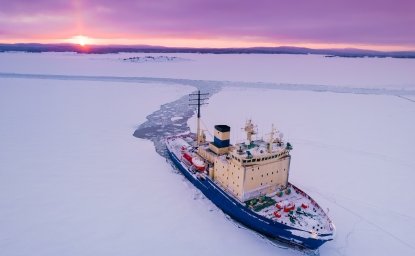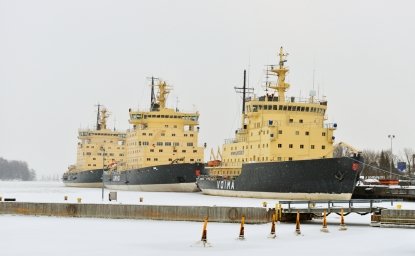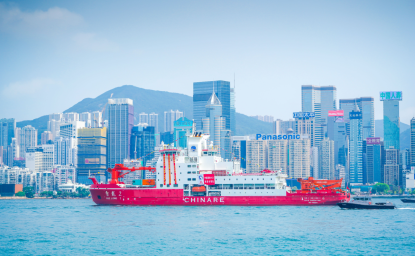THIS IS AN UNEDITED TRANSCRIPT
Hi, I'm John Milewski and this is Wilson Center NOW, a production of the Woodrow Wilson International Center for Scholars. My guest today is Rebecca Pincus, director of the Wilson Center's Polar Institute. Previously, Dr. Pincus has taught at the U.S. Naval War College and served in the office of the Secretary of Defense as Arctic and climate strategy advisor.
She joins us today to talk about a new pact between three nations called the Ice Pact and its implications for the U.S. in both the Arctic and the Antarctic. Becca, welcome. Thanks for joining us. Thank you, John. So Canada, Finland, U.S.. This enhanced trilateral partnership. I love the naming. Right. The ice pack standing for icebreaker collaboration effort. I'm sure that I am see came easily.
But the E was probably a little bit of work when they were going through the naming. Talk to us about the significance of the ICE pact. Sure. I think the ice pact is best understood in context because on the surface it's an agreement to collaborate. It's the start of a process. The United States, Canada and Finland will be working out details of a memorandum of understanding throughout the rest of this year.
So we're at the start of a process and the announcement is a declaration of intent. But if you put it in the broader context, in which ICE pact follows on the heels of orcus the U.S., Australia, the United Kingdom Agreement on submarines, if you put it in the context of the broader efforts to expand Navy shipbuilding maintenance and repair overseas, I think you begin to see a pattern here.
The United States is really in a in a crisis situation really when it comes to shipbuilding. And our maritime industry and many of our allies are also facing similar sort of crisis points when it comes to kind of key defense industry capabilities. And so I think we're seeing more and more of these novel, you know, mini lateral type agreements that are aimed at rapidly scaling up defense industry capacity in key areas.
And icebreakers are one of those kind of key niche areas. So I think this is really exciting in that broader context. So pooling of resources almost an icebreaker, pull up. Well, what are the roots of the crisis? How did we get here? So icebreakers are incredibly amazing platforms. They're super complex. Right. I mean, generally, if you're out driving a ship around, you steer away from the ice.
But icebreakers drive right into it. And they, you know, particularly polar icebreakers, the really heavy polar icebreakers that are, you know, at the heart of this agreement. They are just remarkable ships. They drive into ice that is many feet thick and that's ice that would crush a ship's hull. And they operate in storms that both polar regions have incredibly terrible weather with storms that that accrete ice onto a ship's top structure.
So, you know, if you are operating a ship in the Arctic or in Antarctica, you're going to start building up ice on the the superstructure of your ship. And eventually, if you're not careful and depending on the construction of your ship, you'll become top heavy because there's so much weight of ice way up high. And that's a real hazard.
And that's those those are just a couple of the many, many operational hazards you face in the polar regions. So when you think about the engineering requirements for icebreakers, they're just daunting. Right. I mean, these ships have to operate in some of the worst conditions on the planet. And, you know, the polar regions are really, really far away in terms of sustainment, in terms of, you know, repair facilities.
So they just have to be incredibly tough. They're incredibly hard to build. And in the United States, we haven't built a polar ice breaker in decades. And we built a couple of heavy icebreakers in the 1970s. We built those for the Polar Star in the Polar. See, we built the Healy in the 1990s, and that's been in for the big ones.
So it has been several years or several decades. And the reason that we have not been able to keep that up is because these are expensive, because we don't have a huge fleet of them, right? So each one costs a fair amount. You don't get the kind of benefits of scale that you would with a larger by and because in the United States, our icebreakers are operated by the Coast Guard, and the Coast Guard is a is a tiny little organization.
You know, the Coast Guard's entire budget is, you know, ten, 11, $12 billion and icebreaker is almost a billion. So, you know, just about, you know, 10% or so. And that means that it's really, really hard to fit icebreaker construction inside a normal budget cycle. Do you have a sense of what the size of the fleet is currently and sort of what the gap is, where it should be based on need?
So right now, the Coast Guard operates the Polar Star and the Healy, and those are two polar capable icebreakers, and that's it. And the Polar Star is older than me by a fair amount. It was launched in the late 1970s, and the Healy was launched in the late 1990. So they're both fairly old ships. The Healy is what you could call a medium class icebreaker.
It is very formidable, but it is built mostly for science. And so the Coast Guard, the U.S. Coast Guard plans to build about 6 to 8 heavy polar icebreakers. Those have not all been funded. And so what you mentioned science. What are the main applications? I'm guessing security is part of it. I'm guessing commerce could be part of it.
What what are the needs? What I mean, what are the specific needs that are filled by these these ships or icebreakers can get to places where no other surface ship can go. So if you think about the U.S. military being able to do anywhere in the world at any time. Icebreakers are a key, key enabler there. They're a key part of that year round presence at the you know, the D.O.D. likes to say that they operate at the the time and place of their choosing anywhere in the globe.
And so if you think about it, in the polar regions, at certain times of the year, you need an ice breaker to get there. So for the U.S. security guarantee, first of all, to back up our assertion that we can go anywhere, any time you need an icebreaker, the Coast Guard uses those icebreakers to conduct a whole variety of missions because it's an agency with 11 different statutory missions.
And that would include defense missions. It would include, you know, security, protecting the United States and enforcing fisheries, conducting search and rescue and touring sovereignty. You know, all a whole host of missions in both polar regions, I should note, both in the Arctic and in Antarctica. So it's one of those things where sometimes you don't know what it's you need it for until you need it.
Yeah. The White House announcement, Becca, just reading a portion said building best in class. Continue to build best in class, Arctic and polar icebreakers and other Arctic and polar capabilities in each of our respective countries. What what falls under that other category that this agreement? Well, I think it's going to be interesting to see what they come up with.
Obviously, icebreakers are the headliner, but there are also other critical polar capable, you know, aircraft. We in the United States operate a fleet of ski equipped C-130s, which are truly remarkable. Imagine landing a C-130 cargo plane on the ice, though. That fleet also needs to be recapitalized. It'll be interesting to see if that kind of capability is included.
Other types of cold hardened communications equipment, survival equipment. You know, there's a whole host of really specialized, exquisite, cold, capable things that you can imagine this type of agreement supporting. And so I think it is going to be very interesting to see where the agreement gets over the next six months. Again, if you look at orcas as sort of the example, orcas is nominally about submarines, but it's a much bigger agreement.
And I think that is you know, this is sort of this is sort of like a mini or a reverse orcas. It has the potential to really stitch these countries together when it comes to polar capabilities in ways that will hopefully, you know, kind of spread far beyond the original intent. And about that that spread or that larger context.
The South China Morning Post had a headline after the announcement of the agreement. U.S., Canada and Finland signed Polar Icebreaker deal in Challenge to China. So that's how they were framing it in the term in terms of geopolitics. How much of this is about challenges from whether it be China or Russia or other players in the Arctic? Again, I mean, I think we talked about the broader context where this agreement is in line with a host of efforts by the U.S. and its closest allies to get more ships faster.
And, you know, absolutely, China is building icebreakers faster than we are. And that is a concern, just as China is building ships, navy ships, commercial ships, much faster than the United States. And it's I think we're seeing these sorts of creative arrangements emerging out of recognition that we are in a place now where we have to think outside the box.
The concerns around industrial policy, around protecting domestic shipbuilding, around, you know, just sort of the challenges of doing things differently. Those have to be, I think, now placed in the context in which we have a competitor that is cycling faster than we are. And so I think it's is really good to see some interesting creative approaches that also take advantage of the U.S. is greatest strength, which is our network of allies and partners.
That's that is our competitive advantage over China. And so I think we're leaning into that space, and that's really exciting. Again, looking at the White House release, the final sentence says it's about providing the capability for like minded nations to uphold international rules, norms and standards to sustain peace and stability in the Arctic and Antarctic regions for generations to come.
And so embedded in that, reading between the lines, there are threats to those things. And you can correct me. I mean, obviously I follow this largely through your work and through your predecessor, Mike Sprague, his work. And over that time, I know both of you in the past have talked about how the Arctic was the exception to a lot of rules when it came to cooperation and then Russia invaded Ukraine.
And suddenly those dynamics have begun to change. And so how much of this is anticipate nation that the Arctic and Antarctic can become new areas for conflict versus what has historically been cooperation?
I think we're all hoping that the polar regions stay stable. They are unique special places, but they are places where our competitors are increasingly undermining the rules based order. And so it's important that the US can be present in the Arctic and in Antarctica to defend our interests and uphold the rules based order. And I'm really glad that this announcement mentioned Antarctica as well, because, again, that brings in a whole set of new allies like Australia and New Zealand.
And it also, you know, I think flags, as you said, these are areas where we can't we have to pay attention, we have to be present and we have to work to maintain stability in the rules based order, particularly in Antarctica, because it's it's the nameless ultra of the rules based order without without the Antarctic Treaty system. What do we have?
And so I think you know, this agreement is about practical capabilities. It's about the platforms that the U.S. and its allies use to get to places like the Arctic and Antarctica. But behind that is why would we go there? We go there to assert our interests, to uphold the rules based order and to push back against, you know, adverse activities.
We are seeing every year China conducting research expeditions in the Arctic that are obviously dual use. They're obviously conducting, collecting intelligence and testing and prodding and probing at U.S. responses. Similarly with Russia and you know, in Antarctica, there are similar attempts to to sort of erode and test the rules based order. And so we can make all the statements that we like.
But if we can't back up our interests and our intent with the physical presence, then, you know, we run the risk of those words being meaningless. And so I think this agreement is a really good connection between our interests, you know, our strategies and our statements and on the capabilities that we need to to follow them up. Becky Help us set expectations.
As for how quickly this significant agreement can begin to actually yield benefits in the sense that, you know, you talked about a fleet of two that's older than you that, you know, that takes a long time to build because of the complexity of these machines. What is a real excessive expectation of how quickly we can start to see benefits from this cooperation?
Absolutely. There are a lot of legal requirements that mandate that the U.S. Coast Guard and Navy build ships in the United States. And we know that the US shipbuilding industry is under severe challenge right now. Pretty much almost every shipbuilding program and repair program is behind schedule and over cost across the Navy and the Coast Guard and the Coast Guard.
The current Coast Guard Icebreaker acquisition program, the polar security cutter is is years behind schedule and way over cost. Those problems are not going to be ameliorated immediately by this agreement. But I think it cracks open the door to to maybe making some adjustments in the rules that govern shipbuilding. I would put this agreement next to the recent congressional action just a few weeks ago that gave the Navy permission to expand overseas repair and maintenance, which again, is something that historically has been very tightly limited.
But Congress has moved to give the Navy greater flexibility in using overseas repair and maintenance because they recognize that we need to repair Navy ships and we cannot do it fast enough here. So we have to look elsewhere. And that was a hard battle. There's a lot of really important interests at stake. You know, we're balancing our defense interests against our domestic shipbuilding industry, our labor industry interests.
And it's a very sensitive area to walk. And you can see that this ICE pact agreement kind of sidesteps some of those those sensitive pressure points. It's got three components information sharing and the workforce development. And then the third element is encouraging allies and partners to purchase icebreakers from the U.S., Canada and Finland. I think the workforce development may actually be one of the most important and interesting areas to watch where we could potentially see the fastest movement because there is a great deal of icebreaker building expertise in Finland and Finland has historically been building icebreakers at a rapid clip.
It's one of their their sort of niche strengths. And so I think if they can share some of their expertise, if we can maybe do some workforce exchange and training opportunities, that might make it easier and faster for the U.S. shipyards to come up to speed to regain some of the expertise that has has, you know, eroded in this country.
And so I think that would be the area to watch. But again, this is not a this is not a silver bullet. This is the first step in a process. And I think we will like orcas. It it it should be looked at in terms of the net benefits in five, ten, 20 years down the road when hopefully the US will have regained its ability to build top of the notch for icebreakers.
Now playing the long game, which is different, often we tend to put out fires, so this is actually refreshing in that regard. Final thoughts, Becca is about just the the situation in general. You know, a lot of when we've talked about whether the Arctic or the Antarctic, we've been talking about the impact of climate change and the changing oceans and the melting of ice, with or without icebreakers.
Give us an overview of where things stand now and what are the the hot topics. And I'm sorry if that sounds like a bad pun, not intended to be, but, you know, you and I are sitting here recording this in a city that is now about 99 degrees on the thermometer and 102 degrees. And the feel like when you're roll in the humidity.
So this is always they're almost like white noise for us at this time of year. The reality of of a warming planet. Yeah absolutely. And that continues to be the grim backdrop. The polar regions are warming very quickly. And, you know, there's a lot of excitement about the Arctic being, you know, open to activity, more shipping, all that kind of thing.
But but the reality is that, you know, operational conditions are getting more dangerous. There is a lot more floating sea ice, there's more hazards, there's worse storms, there's more coastal erosion. We are going to see more, you know, natural and human disasters in the Arctic region. And I would point to the major Norilsk Nickel spill a few years ago, the tsunami in Greenland back in 2017.
These are climate related disasters and there are going to be more of them. And so I think I get asked all the time, why does the U.S. need more icebreakers if the ice is melting? And I say, you know, I appreciate that, but more people are going up into the Arctic and the conditions are actually more dangerous and so I think we are going to have a greater need for the Coast Guard to be able to be there year round to rescue people to to address and respond to environmental disasters than ever before.
And it's critically important that we have the platforms and the ships that enable the coast Guard to go up into incredibly dangerous conditions and do their work to save lives, to protect property, to defend the environment. And so I think, you know, the need is is only increasing as there's more activity in the polar regions. And the conditions are very, very challenging.
It's it is not a the loss of sea ice is driving a lot of unpredictability and unexpected conditions in the Arctic. There are sudden freeze ups. There are early thaws, you know, really bad storms. So I think a lot of people, you know, that the idea, the sort of rush to judgment that, it's getting a lot easier to operate up there, it really tap the brakes on that.
It's an incredibly difficult condition operating environment and it's changing so fast. You know, the Arctic is warming faster than anywhere else on Earth. There are parts of the Arctic region that have already warmed four degrees Celsius. And, you know, we're down here worried about one and a half. So I think it's it's just a shocking rate of change up there.
And it's incredibly important that we keep our eye on those changes and position ourselves as best we can to adapt because they're happening before our eyes. Well, thank you, Rebecca. Always fascinating. And as you talk, these are unique areas of the globe, unlike any other places. And so I want to give a plug to you and the Polar Institute.
To our viewers and listeners, if you come to the Wilson Center and look at the programs tab at the top of the Web page, you can then find the Polar Institute. And Rebecca and her team have been ahead of the curve on this for a long time and continue to be so. Thank you for your ongoing work. Thank you, John.
Really appreciate it. We hope you enjoyed this edition of Wilson Center now and that you'll join us again soon. Until then, for all of us at the center, I'm John Milewski. Thanks for your time and interest.







